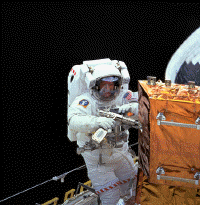Space weather
What is space weather?
 |
|
The Sun-Earth connection: solar storms originating on the Sun affect Earth's space environment |
Our Sun plays a central role in daily life, by warming and lighting the world, and powering the growth of living plants. Since ancient times, mankind has been aware of its importance, although not always understanding how or why. Now in the space age, man-made satellites monitor and probe the environs of the Sun, observing subtler and sometimes damaging effects on Earth. Studying this "space weather", the collective term used to describe effects originating from the Sun, is an increasingly important activity in our technology-dependent society.
Space weather effects
|
The numerous effects of space weather (Bell Laboratories, Lucent Technologies) |
Hazards to satellites and astronauts
Modern space- and aircraft carry highly advanced components which are susceptible to the energetic charged particles and plasmas present in the Sun-Earth environment. These charged particles can change the behaviour of electronic components in an unpredictable manner. In the worst case scenario, a satellite could be lost because of damage to some vital component. Aircraft are also increasingly vulnerable as more functions come under electronic control.
 |
|
European astronaut Claude Nicollier during an extra vehicular activity on a Hubble servicing mission |
Space weather conditions can also be hazardous to humans in space. Astronauts are normally well protected by large shielding in space stations. However during an Extra Vehicular Activity (EVA) they are exposed to the same dangers as a satellite. If an eruption of energetic solar particles is in progress, then astronauts must remain protected within the space station in order to avoid exposure to lethal doses of particles or radiation.
Communication blackouts
The Earth's ionosphere is important for radio communications. Solar flares can upset the composition of this layer causing communication blackouts. A wide range of communication activities can be affected such as navigation systems, search and rescue activities, satellite control activities, to name a few.
Effects close to home
Space weather doesn't just affect objects or people in space. The effects can be felt even closer to home. Power-line failures and corrosion effects observed in pipelines on Earth may be the direct result of space weather induced effects. Transformers in power systems may be saturated leading to disturbances of the systems or even to permanent damage. Pipelines carrying essential fuels can be adversely affected by space weather conditions since geomagnetically induced currents may flow from the pipe into the soil increasing the corrosion rate. The voltage caused by this current can disturb the protection systems in the pipe.
Space weather forecasting
Forecasting the space weather can alert us to upcoming solar storms and appropriate actions can be taken to minimise the impact of these events. The ability to forecast comes from our improved understanding of solar events which has been facilitated by solar physics research, including important contributions from six spacecraft built in Europe: SOHO stationed far out in space, the four Cluster satellites orbiting together around the Earth, and Ulysses, which flies over the poles of the Sun.
How do we forecast space weather?
 |
|
Aurora near Aberdeen, UK, 27-November 2000 (Noreen Harding) |
Space weather forecasting is a little like forecasting the weather on Earth. Certain physical processes are good indicators of the weather. For example, on Earth an approaching low pressure system indicates that rain is likely, while sunspot activity on the Sun is a good indicator of changing space weather conditions in the Sun-Earth environment. Careful study of current conditions between the Sun and Earth, comparison with past situations and the use of computer models all contribute to a space weather forecast. These days space weather forecasts cover periods from hours to days.
Space weather isn't all bad. It is also the source of the aurora borealis (Northern Lights) and the aurora australis (Southern Lights). In the future, space weather may even be harnessed as a source of energy.
